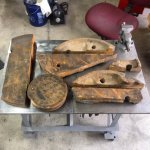capocoreyollo
Aluminum
- Joined
- Jul 22, 2015
Hello all,
From what I see and read, gray iron seems to be the preference, but would ductile iron work as well?
I ask as I'll be doing a job for a friend in the construction trade and he has a lot of manhole and city utility covers that he's willing to cut up for me. It seems that they're primarily gray iron, but it made me wonder.
I'd like to make some surface gages, bench blocks, tool maker flats,other random tools,etc. Maybe even a small straight edge for working on my small hobby machines at home, or even a new compound for my bench lathe.
I suppose ductile iron would be a little harder to scrape opposed to the gray?
Am I crazy for wanting to make tools out of a sewer plate?
Corey
From what I see and read, gray iron seems to be the preference, but would ductile iron work as well?
I ask as I'll be doing a job for a friend in the construction trade and he has a lot of manhole and city utility covers that he's willing to cut up for me. It seems that they're primarily gray iron, but it made me wonder.
I'd like to make some surface gages, bench blocks, tool maker flats,other random tools,etc. Maybe even a small straight edge for working on my small hobby machines at home, or even a new compound for my bench lathe.
I suppose ductile iron would be a little harder to scrape opposed to the gray?
Am I crazy for wanting to make tools out of a sewer plate?
Corey







